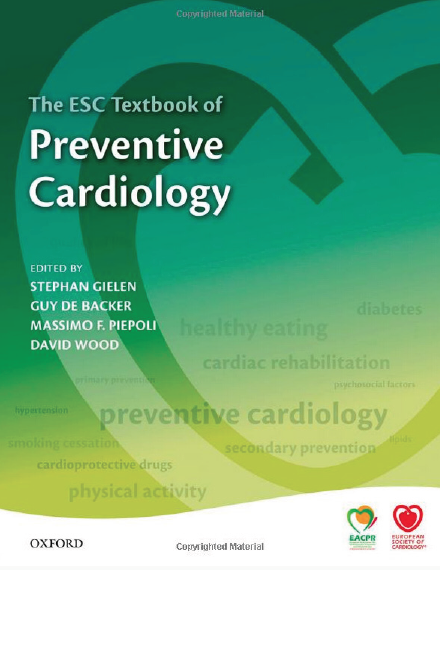The ESC textbook of preventive cardiology

Publisher: Oxford University Press, 2015
ISBN: 978-0-19-965665-3
Price: £115 (print), £29 (online, 1-year subscription)
It is widely accepted knowledge among health professionals and the general public that premature cardiovascular disease can be prevented. However the evidence and guidelines on prevention are typically scattered, making integration into clinical practice problematic. The ESC textbook of preventive cardiology aims to collate all the aspects of prevention into one textbook.
While the title may give the initial impression that the editors are going to be providing the old rhetoric on hypertension, smoking and lipid control, a quick glance at the preface and contents reveal that they are aiming far beyond these basics.
The editors correctly point out that “there is no book that unites” the principles and practice of preventive cardiology. They are promising “a single resource” with a “practical hands-on approach”, that will help the reader integrate the knowledge in this book into their clinical practice. In the preface it is stated that this book is not only aimed at doctors but any health professional that has to deal with cardiovascular disease. It’s available in both print and digital formats with the online version to be updated when new evidence becomes available.
The initial chapter on epidemiology swiftly brings the reader up to date with the past 60 years of research into the prevention of cardiovascular disease. While it is clearly outlined that mortality has significantly improved, the reader is presented with evidence for a potential “new phase of the epidemic” of cardiovascular disease mainly related to the meteoric rise of obesity and diabetes. This is an overarching theme that appears time and time again throughout the book.
Chapters dedicated to modification of risk factors are expertly written and provide the reader with the current evidence and guidelines for management of patients. Clinical application is further supported by accompanying case studies for which a solution is provided at the end of each chapter. The cases are well thought out and thoroughly explained making them a valuable addition to the textbook and well worth reading.
Of particular note to me was the section on imaging in cardiovascular prevention. This is an area I’ve previously found a minefield with both understanding the indications, relative advantages and disadvantages and interpretation of the numerous imaging modalities available within cardiovascular radiology. Extensive, but clear, tables outlining the various properties of each modality are of great reference to anyone regularly ordering and interpreting cardiovascular radiology.
The editors admit in the preface that this textbook “will not be perfect in all aspects”, and there are areas in which this is true. Risk assessment is a fundamental backbone of prevention, but the section on this mainly pertains to use of the SCORE risk estimation system. Writing from a UK perspective, where QRISK and the more recent JBS3 guidelines (which are notably completely absent from the comparative table), makes the risk assessment section less applicable than it could be. Also, focussing on the SCORE system and its unique use of 10-year risk of mortality rather than risk of events, which it admits is not “universally popular”, I feel adds confusion rather than simplifying the issue.
I found the delivery of preventive cardiology sections not hugely useful. They seem squarely aimed at how to set up a service. Tables outlining the minimum equipment requirements, personnel and organisational issues could be better laid out in books covering cardiac rehabilitation already available.
Overall, I feel the book succeeds in its aim to provide a valuable single resource for the health professional faced with assessing and managing patients and their cardiovascular risk. The evidence and subsequent guidance offered brings the reader up to date and also gives a glimpse of what trends and developments may be around the corner. Not all sections will be applicable to everyone but with such a wide proposed audience base that’s to be expected.
The fervent tone of the book promises to update the digital version and the simple fact that this one of the first books (and the only one in the past five years) dedicated to this subject make this a valuable resource to any health professional that is involved in cardiovascular prevention.
Jonty Bennett
FY2 Doctor, London
